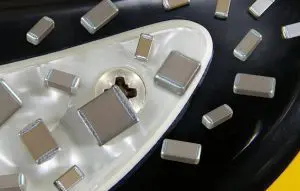source: Electronics Weekly news
Knowles is aiming at electric and hybrid vehicle charging with a range of X7R multi-layer ceramic capacitors (MLCCs).
“The big change being seen in automotive applications is the voltage rating and size of components now being used,” said the firm. “This revolution in MLCC technology, used in control electronics, is being driven by modern on-board charging systems in electric vehicles and hybrid vehicles where mains ac is involved.”
In response, it has created 250Vac X1/Y2 safety-certified MLCCs to 10nF. Available in a 2220 case size, these X7R dielectric capacitors offer greater on-board total capacitance, or a part count reduction.
“For example, they can take the place of 2 x 4.7nF X1/Y2 capacitors connected in parallel to reduce component count, size and weight”, claimed Knowles.
All Knowles Safety Certified capacitors comply with international UL and TÜV (UL ongoing) specifications, allowing surface mount ceramic multilayer capacitor to replace leaded film types for simple pick-and-place assembly, reduced board space and lower profile.
The devices are also available in a ‘FlexiCap’ version to reduce the risk of mechanical cracking.
Now in pre-production, according to Knowles, the 10nF, B16 parts have already been by approved by major automotive manufacturers and under review by several others.
Applications also include: AC-DC power supplies and plug-in charging systems where circuits are connected to the mains and lightning strike or other voltage transients represent a threat to electronic equipment.
































